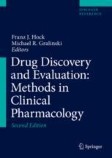Search
Search Results
-
Neural Network Models for Predicting Solubility and Metabolism Class of Drugs in the Biopharmaceutics Drug Disposition Classification System (BDDCS)
Background and ObjectiveThe biopharmaceutics drug disposition classification system (BDDCS) categorizes drugs into four classes on the basis of their...

-
Predictive Potential of BCS and Pharmacokinetic Parameters on Study Outcome: Analysis of 198 In Vivo Bioequivalence Studies
Background and ObjectivesUnderstanding predictive potential of parameters to perform early bioequivalence (BE) risk assessment is crucial for good...

-
The Unphysical Hypothesis of Infinite Absorption Time
This chapter describes the extensive use of first-order kinetics in oral drug absorption phenomena along with the governing role of the absorption...
-
A Perspective on Model-Informed IVIVC for Development of Subcutaneous Injectables
Subcutaneously administered drugs are growing in popularity for both large and small molecule drugs. However, development of these systems –...

-

-
Drug-Drug and Food-Drug Interactions of Pharmacokinetic Nature
The most relevant pharmacokinetic mechanisms of drug-drug (DD) and food-drug (FD) interactions are summarized from a perspective that will allow the...
-
Route-Specific Challenges in the Delivery of Poorly Water-Soluble Drugs
Poor aqueous solubility of new chemical entities presents various challenges in the development of effective drug delivery systems for various...
-
Drug Properties
Drug discoveryDrug discovery remains a complex and iterative process accompanied with a high failure rate. Before compounds enter the clinic,...
-
IVIVC Revised
PurposeTo revise the IVIVC considering the physiologically sound Finite Absorption Time (F.A.T.) and Finite Dissolution Time (F.D.T.) concepts.
...
-
Assessing Food Effects on Oral Drug Absorption Based on the Degree of Renal Excretion
Food intake influences the pharmacokinetics of orally administered drugs by altering drug absorption, metabolism, and excretion. A drug which is...

-
An Explanation of Why Dose-Corrected Area Under the Curve for Alternate Administration Routes Can Be Greater than for Intravenous Dosing
It is generally believed that bioavailability ( F ) calculated based on systemic concentration area under the curve (AUC) measurements cannot exceed...

-
Hepatic Impairment Physiologically Based Pharmacokinetic Model Development: Current Challenges
PurposeThis review summarizes the development processes of hepatic impairment (HI) PBPK models, examines current challenges, and proposes potential...
-
Revising Pharmacokinetics of Oral Drug Absorption: I Models Based on Biopharmaceutical/Physiological and Finite Absorption Time Concepts
PurposeTo demonstrate that oral drug absorption is terminated in finite time. To develop models based on biopharmaceutical/physiological and finite...

-
In/In Vivo Correlation for Transporters
Membrane transporters play one of the key roles in drug disposition and drug-drug interactions. Therefore, one of the prerequisites in the...
-
Translational Modeling Strategies for Orally Administered Drug Products: Academic, Industrial and Regulatory Perspectives
During non-clinical and clinical development of a new molecular entity (NME), modeling and simulation (M&S) are routinely used to predict the...

-
In Vitro/In Vivo Correlation for Transporters
Membrane transporters play one of the key roles in drug disposition and drug-drug interactions. Therefore, one of the prerequisites in the...
-
Dissolution and Translational Modeling Strategies Toward Establishing an In Vitro-In Vivo Link—a Workshop Summary Report
This publication summarizes the proceedings of day 2 of a 3-day workshop on “Dissolution and Translational Modeling Strategies Enabling...

-
Drug Disposition Classification Systems in Discovery and Development: A Comparative Review of the BDDCS, ECCS and ECCCS Concepts
BDDCS, ECCS and ECCCS are compound disposition classification concepts that aim to streamline, de-risk and speed-up drug development. Although all...

-
Why Drugs Fail in Late Stages of Development: Case Study Analyses from the Last Decade and Recommendations
New drug development is both resource and time intensive, where later clinical stages result in significant costs. We analyze recent late-stage...

